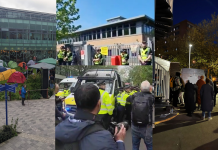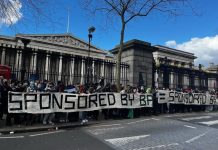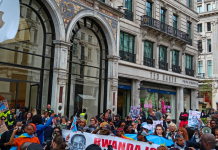‘Beijing and the Hong Kong government have succeeded in producing a genuine mass movement which will not easily be demobilised’. Sue Sparks reports on the mass protests in Hong Kong earlier this week.
July 1st in Hong Kong is Handover Day, the anniversary of the handing back of Hong Kong by the British to China in 1997. It is a public holiday, marked by official celebrations, but also by a demonstration. In some years this simply brings together a rather motley collection of people with many different causes, but in other years it has been a massive display of public feeling on a particular issue; for example in 2003, when around 500,000 people marched against the introduction of national security legislation.
This year there was also a massive mobilisation on July 1st – though the police estimated only 98,000, the march took seven hours to reach its destination and photographs from above show huge crowds. It seems likely that the turnout was similar to 2003, around the half million mark, and certainly the largest since that year. Very large sums of money were collected on the march by the organisers, Occupy Central (HK$1.39 million – £105,000) and by the radical League of Social Democrats (HK$930,000 – £70,000), whose most famous member of the Legislative Council, “Long Hair” Leung Kwok-hung, is currently in jail as a result of a previous protest.
There were also rumours of supporting actions in mainland China, including just across the border in Shenzhen, where some journalists from Hong Kong hoping to report on an action referred to on social media were detained by the police for several hours. Certainly pictures of the Hong Kong march were posted on Sina Weibo, China’s most popular social media platform, before being removed by censors. According to the media monitoring project at Hong Kong University, Weibo was censored more heavily on July 1st this year even than on the anniversary of Tiananmen.
The march was followed by an all-night sit-in in the road near the government headquarters. Over five hundred arrests were made and those arrested were taken to a temporary detention centre where they were deprived of food and drink, and access to toilet facilities and lawyers, for hours. Most were released with warnings – it is not clear if these are intended to prevent them taking part in other protests. The protesters remained calm and practised classic passive resistance techniques, requiring up to five police officers to remove each person from the road, so it was a slow process. The police did not use pepper spray or tear gas in this instance, but earlier they had penned many people into the park and not allowed them to join the march or to leave and also separated people into smaller groups, tactics which are familiar to people in the UK. Protesters monitored police behaviour, shouting out their badge numbers as they arrested people. In one instance, a pro-Beijing counter-demonstrator slapped a protester in the face and was then surrounded by the crowd until the police rescued him. A group of protesters then chased the police, denouncing them for sympathising with him.
The main issue driving people onto the demonstration was the question of universal suffrage, which has long been promised to Hong Kong. At present, the Legislative Council is partly directly elected, but a built-in majority for pro-Beijing parties is assured by various bits of gerrymandering, including ‘functional constituencies’ which have a handful of electors in many cases, including corporate entities such as banks and property companies. The Chief Executive is ‘elected’ by a small committee and is essentially appointed by Beijing. People may have wondered why people are carrying placards with ‘689’ on them – this is the number of votes received by the current Chief Executive, C Y Leung. The Hong Kong government has this year been engaged in a farcical public consultation about how universal suffrage will be introduced for the next CE election in 2017. Beijing has made it clear that it will not allow nomination of candidates by political parties or by the public, only by a narrow nominating committee, and that candidates must be ‘patriotic’ – so what it is essentially saying is, you can vote, but we will decide the candidates you can vote for.
A movement to push for real universal suffrage, Occupy Central, was founded last year, and is the main force behind the march this year. The plan is to occupy the central business district in Hong Kong Island and block the roads if the government fails to offer a plan for real democracy meeting international standards. Occupy Central organised an unofficial referendum on plans for genuine democracy late last month, using online voting and physical polling stations. Despite a huge denial of service attack on the voting system – at one point three billion requests were bombarding the servers in the space of a few hours – the voting went ahead and 780,000 people registered their votes, using their ID numbers and mobile SIM cards. This was dismissed as illegal and irrelevant by Beijing and the HK government – which has also made no move to investigate the cyber-attack, even though it was extended to the whole .hk domain at one stage, which could have affected the emergency services.
Voting in the referendum and attendance at the demonstration was undoubtedly boosted by Beijing’s issuing of a White Paper on Hong Kong last month, which it said was intended to correct the ‘lopsided’ interpretation of many Hongkongers of the ‘One Country, Two Systems’ principle. Among other things it described judges as ‘administrators’ and said they had to be ‘patriots’, which resulted in a silent march by lawyers wearing black through the centre of Hong Kong. It remains unclear these days exactly what the ‘two systems’ are, incidentally – capitalism, and er, capitalism. But Beijing is very sure it is One Country. There have also been a series of attacks – physical and otherwise – on the media, and journalists have recently voiced their concerns about increased censorship and pressures towards self-censorship.
The situation now is tense. Whereas in previous confrontations the government has simply backed down, in this case, they have no room for manoeuvre, except perhaps to deny any reforms and stick to the existing system. There have been veiled threats to use the PLA (stationed in Hong Kong) to maintain order if Occupy Central led to violence. Occupy is committed to non-violence, but we all know that the police are capable of transforming peaceful protests into scenes of violence if they choose.
Occupy has weaknesses. It is dominated by the pan-democrats, some of whom have been stupid enough to consort with Paul Wolfowitz on his yacht on a recent visit to Hong Kong. The pan-democrats are very divided and it is possible that some could still reach a deal with the government. There is no sign of class mobilisation in the form of planned strikes. But Beijing and the Hong Kong government have succeeded in producing a genuine mass movement which will not easily be demobilised.























CWI section in Hong Kong – Socialist Action – doing fine work during this movement. http://www.socialistworld.net/view/106